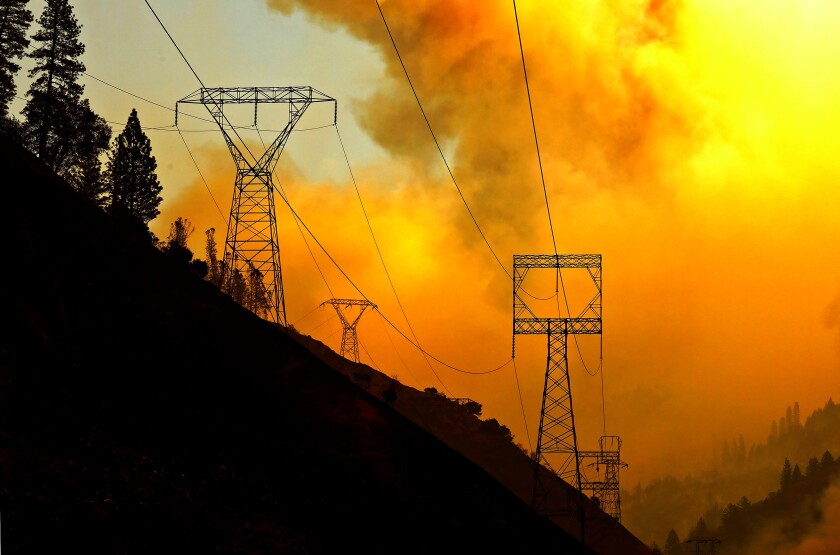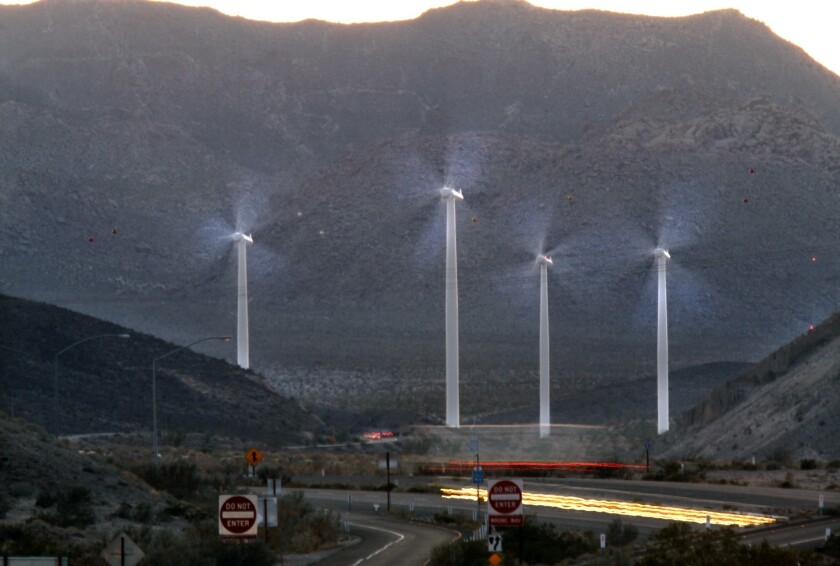California’s monopoly electric utilities asked state officials to sign off on higher profits earlier this year, saying larger shareholder returns were needed to attract investors who might be scared off by the wildfire liabilities that prompted Pacific Gas & Electric to file for bankruptcy.
Now regulators are poised to reject those pleas.
In a proposal issued last week, staff at the California Public Utilities Commission called for keeping profit margins the same for PG&E, Southern California Edison and San Diego Gas & Electric. Commission staff noted that lawmakers “substantially mitigated wildfire liability exposure” when they passed Assembly Bill 1054, which could give utility companies access to billions of dollars to help pay for damages from fires ignited by their equipment.
“There are no remaining significant unmitigated risks that warrant investor compensation” through a higher return on equity, commission staff wrote.
Advertisement
The proposed decision also calls for profit margins to remain the same at Southern California Gas, which like SDG&E is a subsidiary of San Diego-based Sempra Energy. The five-member Public Utilities Commission could vote on the staff proposal as soon as Dec. 19.
The commission is supposed to allow shareholder returns no higher than is necessary to attract investment so that utilities have enough money to pay for infrastructure projects, safety upgrades and the growing amounts of climate-friendly energy required by state law.
Ratepayer advocates say California’s investor-owned utilities would do fine making less money.
The Edison Electric Institute, an industry trade group, recently reported that in 2018, utility regulators nationwide approved average returns on equity of 9.51%, “the lowest annual average in our 30 years of data.” The industry group attributed the decline in approved profit levels to a “long-term decline in interest rates since the early 1980s.”
Advertisement
In California, profit margins would stay level at 10.3% for Southern California Edison, 10.25% for PG&E, 10.2% for SDG&E and 10.05% for SoCalGas under the proposal from state regulators.
That means for every dollar the utilities spend building electric or gas infrastructure, they’d be allowed to charge customers an additional 10 cents or so in profits for their shareholders.

The logo for Pacific Gas & Electric appears above a trading post on the floor of the New York Stock Exchange.
(AP Photo / Richard Drew)
The Public Utilities Commission’s in-house ratepayer watchdog, the Public Advocates Office, had proposed reducing profit margins to 8.65% for Edison and 8.49% for PG&E, SDG&E and SoCalGas. The Utility Reform Network, a San Francisco-based consumer advocacy group, had also asked for lower shareholder returns.
The Utility Reform Network “still believes lower interest rate forecasts and the lower numbers adopted by other states justify lowering CA utility returns below 10%,” spokeswoman Mindy Spatt said in an email.
“We fully expect the utilities to lobby against this proposal and continue their unjustified demands for higher rates,” Spatt said.
Wildfire costs
The three monopoly electric utilities originally asked for dramatically higher shareholder returns, which could have resulted in monthly electric bill increases of $7.85 for PG&E customers, $12.20 for Edison customers and $5.59 for SDG&E customers.
Utility officials said higher profits were needed to balance out the financial risk posed by wildfires.
PG&E has estimated it could face $30 billion in liabilities from fires sparked by its equipment, including the Camp fire, which killed 85 people and destroyed the town of Paradise. Edison recently estimated its potential liabilities from the Thomas and Woolsey fires and the Montecito mudslide at $4.7 billion.
After the passage of AB 1054, the three utilities substantially lowered their requests. But they still asked for higher profits.
Advertisement
PG&E spokeswoman Ari Vanrenen said the utility’s proposal “is designed to make sure the company can meet the energy needs of its customers by attracting the critical funding necessary to invest in and increase the safety and reliability of its energy system while helping reduce California’s wildfire risk.”
“We recognize that any increase to customer bills can be challenging, and PG&E is committed to keeping costs as low as possible while meeting our responsibilities to safely serve our customers,” he said in an email.

A PG&E power line was found to have ignited the Camp fire.
(Carolyn Cole / Los Angeles Times)
State officials “basically split the baby” by recommending that profit margins stay the same rather than endorsing either side’s arguments, said Loretta Lynch, a former president of the Public Utilities Commission. Lynch is a board member at the Protect Our Communities Foundation, a San Diego-area group that also called for lower utility profits.
“The commission threw a dart. There’s no evidence on the record for the numbers they came up with,” she said.
SDG&E spokesman Wes Jones said in a written statement that the utility is “evaluating the Proposed Decision and will work through the regulatory process in the coming weeks leading up to the final decision.”
A SoCalGas spokesman declined to comment on the proposed decision.
Moving quickly on climate
Ron Gales, a spokesman for Southern California Edison, said the company “welcomes several aspects of the commission’s [proposed decision], including approval of SCE’s requested capital structure and the commission’s timeliness in managing the proceeding.” He added that Edison “continues to assess the [proposed decision] and the treatment of unique California risks, such as wildfire and industry-leading changes to the electric sector.”
That last bit is a reference to arguments made by all four utilities that California’s aggressive climate change policies create additional financial risks for investors — and that those risks should be compensated with higher shareholder returns.
In a filing to the Public Utilities Commission requesting increased financial returns, Edison cited the state’s mandate of 100% climate-friendly electricity by 2045. Around one-third of California’s electricity now comes from renewable sources such as solar and wind power. But natural gas-fueled power plants are still the state’s largest source of electricity.
Advertisement
The 100% clean energy standard “will require procurement from new technologies at an unprecedented scale” and “creates substantial operational risks for SCE that are greater than those utilities face outside of California,” Edison argued. The utility also mentioned the need for massive investments in electric vehicle chargers and other grid infrastructure to support a transition from oil-based transportation to clean cars.
Public Utilities Commission staff were unconvinced by those arguments, writing in the proposed decision that any financial risks stemming from state climate policies are “already priced into the models.”

Wind turbines spin along Interstate 8 near Ocotillo, Calif.
(Don Bartletti / Los Angeles Times)
Michael Colvin, who leads the California energy program at the nonprofit Environmental Defense Fund, said Edison was “talking out of both sides of their mouth” because the utility has also argued that investments in clean energy and grid modernization can boost profits.
For instance, Edison has proposed spending $561 million over four years to support the installation of 48,000 electric vehicle charging stations. Those types of investment could pay off handsomely for shareholders because utilities can charge customers that roughly 10% premium when they invest in new infrastructure.
Gas versus electricity
The Environmental Defense Fund also advised the Public Utilities Commission to set different profit margins for investments in electric and gas infrastructure at the two major utilities that deliver both commodities, Pacific Gas & Electric and San Diego Gas & Electric.
The Environmental Defense Fund is one of a growing number of climate advocacy groups and state policymakers calling for California to begin taking steps to transition homes and businesses from gas-based heating and cooking to all-electric appliances. The idea is to replace natural gas, a planet-warming fossil fuel, with electricity, which in California increasingly comes from climate-friendly energy sources.
Seventeen cities and counties have passed building codes this year incentivizing or requiring electric appliances in new buildings. Those types of policies have faced pushback from SoCalGas, which argues that people should be able to choose how they power their homes and businesses, and that there are easier, cheaper ways to reduce climate pollution from natural gas than forcing consumers to replace their gas furnaces and stoves.
The California Restaurant Assn. sued Berkeley last month, arguing that the city’s ban on gas hookups in most new residential buildings — set to take effect Jan. 1 — will have a “drastic impact unique to restaurants.”
“This ban would effectively prohibit the preparation of flame-seared meats, charred vegetables, or the use of intense heat from a flame under a wok,” the restaurant association said in a written statement.
The Environmental Defense Fund urged the Public Utilities Commission to consider allowing shareholders at PG&E and SDG&E to earn higher profits on investments in electric infrastructure than in gas infrastructure. That could help the state meet its climate policy goals, Colvin said.
“For any discretionary dollar that a utility is going to invest, are they going to invest in the clean electric grid that we say we want as a state?” Colvin asked. “Or are they going to invest in legacy gas infrastructure?”

Southern California Gas Co.’s Line 235, which exploded near Newberry Springs in the California desert in 2017, underwent extensive repairs for two years.
(Brian van der Brug / Los Angeles Times)
PG&E opposed the environmental group’s proposal, saying it “fails to recognize that maintaining safe and reliable service on the gas system requires capital, for which investors should receive a fair return.”
“PG&E and SoCalGas have continuing responsibility for the safe, reliable operation of their gas systems, and must continue investing in their gas infrastructures to do so,” PG&E said in a commission filing.
SDG&E also wrote that the Environmental Defense Fund’s proposal can be “quickly dispensed with” because it is contrary to Supreme Court precedent on how shareholder returns should be set for utilities.
The Public Utilities Commission’s proposed decision doesn’t set separate returns on equity for gas and electric investments. But it doesn’t accept or reject the environmental group’s arguments, either, leaving open the possibility that the agency could return to the idea the next time utility profits are adjusted.
Business - Latest - Google News
December 03, 2019 at 04:42AM
https://ift.tt/2YajzJC
PG&E and SCE want higher profits. California gets to decide - Los Angeles Times
Business - Latest - Google News
https://ift.tt/2Rx7A4Y
Bagikan Berita Ini















0 Response to "PG&E and SCE want higher profits. California gets to decide - Los Angeles Times"
Post a Comment